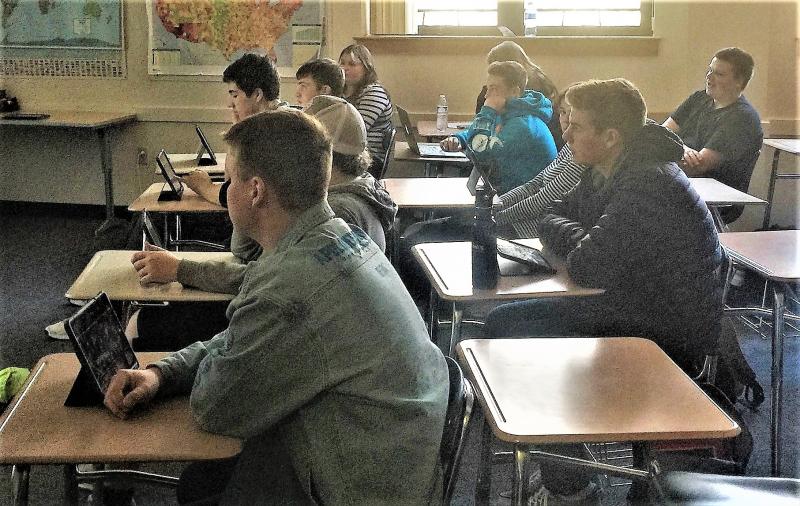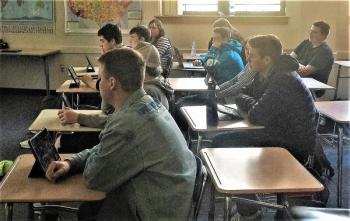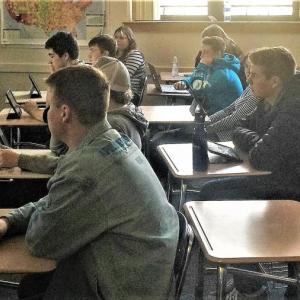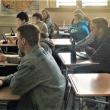Principals talk MEA results
Principal Dan Welch of Boothbay Region High School and Mark Tess of Boothbay Region Elementary School presented the school committee Dec. 12 with the 2017-2018 Maine Educational Assessment (MEA) results.
“We do pretty good with language arts – math is still a bugaboo. Last year I thought we had turned a corner because we went up by five points and I was hoping we were going to go up another five … And science – we just absolutely kill,” said Tess.
Preliminary Scholastic Aptitude Test (PSAT) scores backed up language arts as a strength for BRES students, but the school needs to work on mathematics, particularly geometry, Tess said. The PSAT was introduced to grades eight and nine to prepare students for an SAT type of test, Tess and Welch explained. Maine and 13 other states have mandated the SAT. Welch said Maine’s averages are lesser than some due to this rule, as most states which do not mandate the test usually only turn out students who plan to pursue higher education.
Tess described an issue in how tests are formatted and how grades reflect what is really learned. 2017's fifth grade class scored 35.71 percent proficient in math on the MEA test. The same class scored 56 percent proficient in math on the Northwest Evaluation Association (NWEA) test this fall, said Tess.
Tess believes tracking progress is a combination of efforts which cannot be defined by a single number.
Seventh grade science and math teacher Sandy Wheeler said the NWEA test seems to be a good check on progress and typically comes out to teachers' expectations. However, the MEA results are always expected to be inaccurate due to how the test is formatted and administered.
“We have at least a third of our kids who should be meeting or exceeding our standards,” said Wheeler. “We have a top math group … they should be performing better.”
Like Tess, Welch said the only way to fix low test scores is to identify the underlying challenges students are facing in the classroom. With a state average of 37 percent of students meeting proficiency in math, BRHS had 27 percent of students meeting those standards.
Welch said meeting the state average of proficiency in math on the SATs has been the difference of under five students meeting proficiency (under two students in 2017 and under three in 2016). In small classes, a single student makes a difference, Welch said. He added, BRHS performed about 10 percent overall behind the state average on the SAT.
Superintendent Keith Laser said Tess and Welch are on the right track not just to bring up the scores of their students on various tests, but to inject some confidence and energy into the learning process. “I'm not a big high stakes test guy, but I see some efficacy in doing them and I think it's important to stay the course and … triangulate between the PSAT scores, the MEA scores and the NWEA scores and start to draw some conclusions out of it.”
Welch said that of all the great things about BRHS he could bring to the committee’s attention, he wanted to focus on the MEA scores and testing in general because the results could use a bit of context. For one, the higher level courses in math have been outstanding at BRHS, with 13 out of 14 advanced placement test takers scoring at least a three out of five, he said. It is time to focus on some remediation, and he would expect performance on tests to improve as teachers have been working on remediation programs over the past two years, he said. Also, BRHS will integrate Kahn Academy into the math curriculum. Kahn Academy will personalize a remediation process based on individual PSAT scores.
BRHS will also be continuing its free after school help which Welch said will hopefully have some incentive for students to take.
Said Tess, “As long as there is an issue, we've got to keep trying to find a way to fix it.”
NEASC and playground grant
New England Association of Schools and Colleges sent a letter to BRHS about a two-year progress report the school recently filed. NEASC will be continuing the accreditation.
Welch said NEASC is requesting another progress report for October 2019 to follow up on the school's progress toward more recommendations. “Curricular things and some facility things,” said Welch. “I will say that I find they are pretty receptive to (our limitations). If you look at some of their recommendations, they're not really realistic.”
One of the recommendations was adding a new science lab, which would have been understandable a couple years ago when science teachers were juggling schedules to get multiple classes into the lab, Welch said.
Laser said he is not in favor of participating with NEASC and that with all the accountability systems the schools now have in place like testing and assessments, the schools are doing that job. The next time the choice comes up on whether or not to continue participating in NEASC's program, Laser said the board should feel as though it has options as many schools across the state have opted out of the process.
“For years we were told that if you're not accredited, your kids aren't going to get into good colleges and there's been enough case samples out there of schools that have never been accredited and their kids get into really good schools,” said Welch adding that over the course of 10 years, it costs the CSD about $50,000 to participate in NEASC.
BRES Assistant Principal Tricia Campbell announced a grant she applied for last year through the Mildred McEvoy Foundation out of Western Massachusetts was approved for $25,000. The purpose is to continue into a second phase of new playground equipment for grades three through eight.
Event Date
Address
United States



























